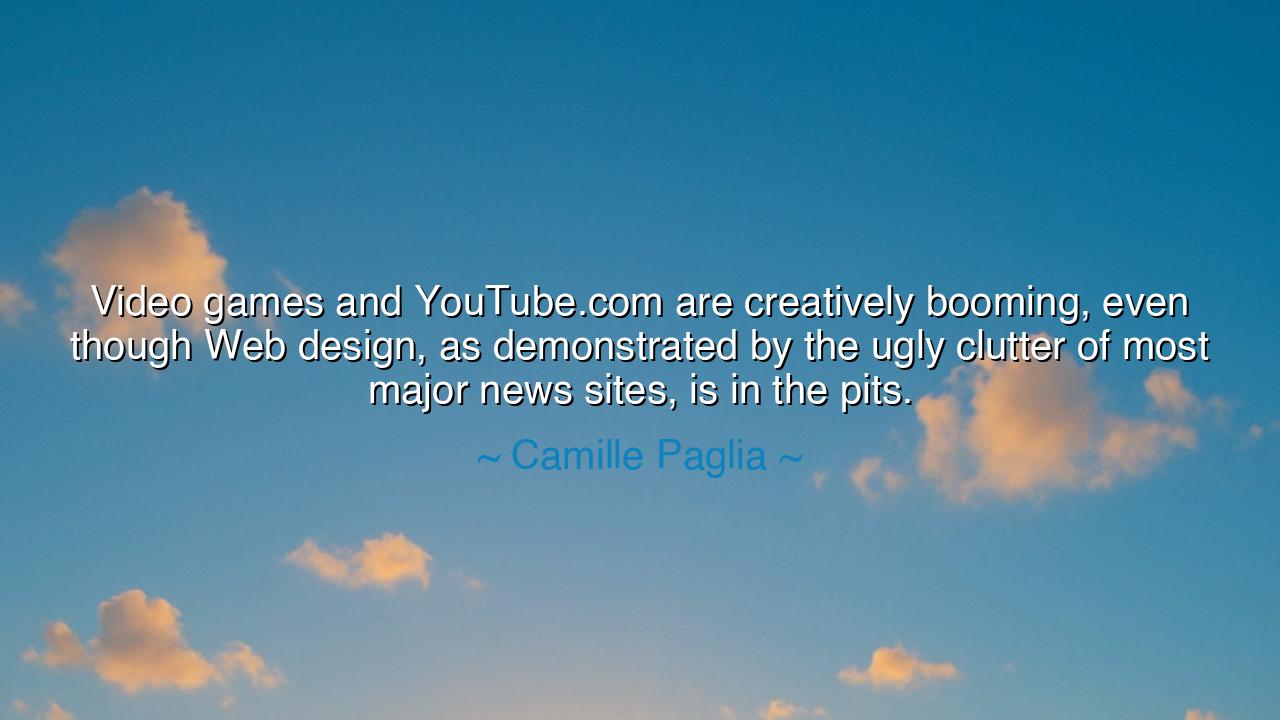
Video games and YouTube.com are creatively booming, even though
Video games and YouTube.com are creatively booming, even though Web design, as demonstrated by the ugly clutter of most major news sites, is in the pits.






“Video games and are creatively booming, even though Web design, as demonstrated by the ugly clutter of most major news sites, is in the pits.” Thus spoke Camille Paglia, the fierce scholar and cultural critic whose words cut through the noise of modern art and media like a sword through fog. In this declaration, she does not merely lament the decline of aesthetic order — she calls attention to the strange imbalance of our age: an era overflowing with creative energy, yet starved of clarity and beauty. Her insight burns with the fire of truth — that art and culture, even when thriving, can lose their soul when their form becomes chaotic, hollow, and directionless.
When Paglia speaks of video games and YouTube as “creatively booming,” she honors the boundless experimentation found in these digital realms. There, countless minds, free from the gatekeepers of old institutions, have forged new worlds, new voices, and new mythologies. The gamer, the streamer, the vlogger — these modern storytellers stand where the poets and painters once stood, shaping the collective imagination of the masses. They are inventing new languages of sound, motion, and interaction. Yet, she contrasts this vitality with the decay of design that pervades other corners of the digital landscape — the tangled, clumsy, and soulless web pages that fill the screens of modernity. In these, she sees not art, but confusion — not design, but disarray.
The origin of this quote lies in Paglia’s enduring love for structure, for the marriage of content and form. A scholar of art, she reveres the clean geometry of Greek temples, the ordered chaos of Baroque cathedrals, and the deliberate symmetry of Renaissance paintings. To her, art has always been about the discipline of beauty — the careful tension between chaos and control. In her eyes, the digital age, though alive with ideas, too often rejects this discipline. The rise of new media has brought freedom, but also fragmentation. Video games and YouTube thrive because they are immersive, because they understand rhythm, movement, and engagement. Web design, by contrast, often collapses under its own weight — overwhelmed by clutter, distracted by its own noise.
In this contrast, Paglia exposes a deeper spiritual crisis. For what she laments is not simply poor design, but the loss of coherence — the inability to see beauty as the harmony between form and meaning. Ancient builders raised monuments that could stand a thousand years because they understood proportion and purpose. The Parthenon, the Taj Mahal, the Great Pyramids — all embody the same eternal law: that art must serve clarity and order. But modern screens, flooded with ads, pop-ups, and chaos, reflect a world that has forgotten how to listen to that law. They mirror the human mind in its distracted state — brilliant, but scattered; full of potential, yet starved of peace.
Consider, for example, the story of the Bauhaus movement in early 20th-century Europe. Its founders — Walter Gropius, Paul Klee, and others — sought to unify art, design, and technology. Their vision was simple: to restore beauty to function, to make even the most ordinary object speak with grace. They believed that every chair, every window, every page could be a work of art if it was made with intention. In their schools, form was not an afterthought, but the body through which spirit spoke. That same spirit, Paglia implies, has been lost in much of today’s digital design — replaced by haste, distraction, and the shallow pursuit of clicks.
Yet, she does not condemn the age entirely. In her praise of YouTube and video games, she recognizes the persistence of the creative fire — the instinct that drives humankind to imagine, to build, and to play. For within the apparent chaos of the internet, there still beats the heart of invention. The young, untamed, and curious continue to give birth to new forms of expression — unpolished, but alive. It is from these crucibles that the next Renaissance may emerge. The rawness of the gamer, the vlogger, the digital artist may yet become the architecture of tomorrow’s beauty — if only they can learn to temper freedom with form, and energy with discipline.
The lesson, then, is one of balance. Creativity without structure becomes noise; structure without creativity becomes stone. The ancients knew this, as did every master of art since. If we would create work that endures — be it a website, a song, a video, or a world — we must seek the union of clarity and passion, of design and soul. In your craft, do not rush to fill space; shape it. Do not mistake movement for meaning; let every choice carry purpose. Like the sculptor who listens to the marble, let your designs emerge not from haste, but from harmony.
So let Paglia’s words be a reminder to all who create in this digital age: technology is the new temple, and design its sacred geometry. Let us not fill it with noise, but with light. Let us learn again the discipline of beauty, where each pixel, each sound, each motion serves a whole greater than itself. For though creativity may bloom in chaos, it finds eternity only in order. And when passion and precision walk hand in hand, art — whether carved in stone or coded in light — becomes what it has always been: the voice of the divine made visible.






AAdministratorAdministrator
Welcome, honored guests. Please leave a comment, we will respond soon